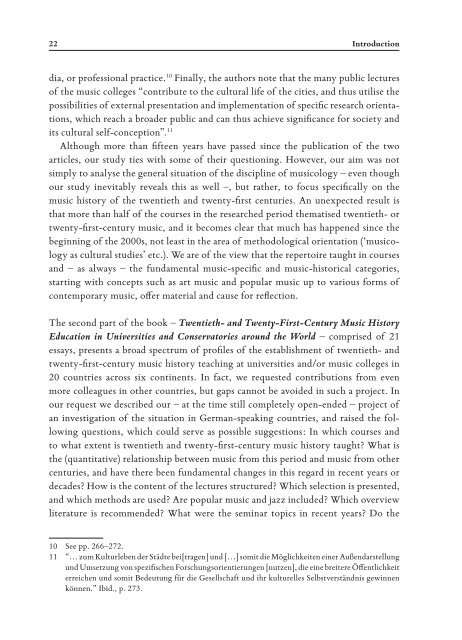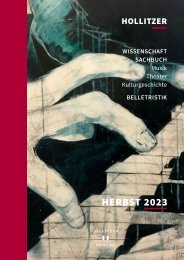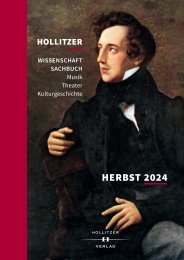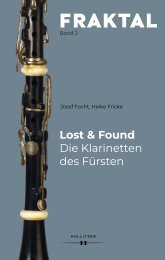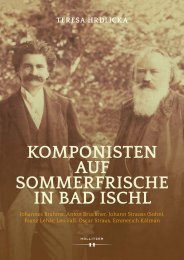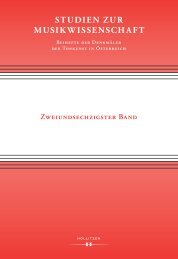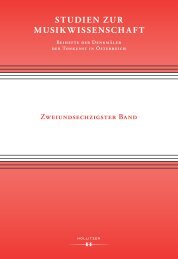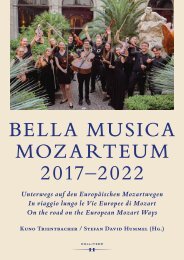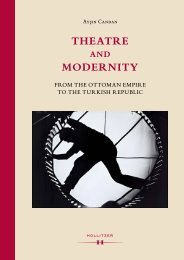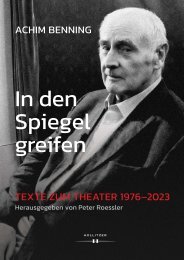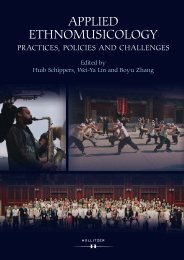Leseprobe_Anklaenge 2018
Erfolgreiche ePaper selbst erstellen
Machen Sie aus Ihren PDF Publikationen ein blätterbares Flipbook mit unserer einzigartigen Google optimierten e-Paper Software.
22 Introduction<br />
dia, or professional practice. 10 Finally, the authors note that the many public lectures<br />
of the music colleges “contribute to the cultural life of the cities, and thus utilise the<br />
possibilities of external presentation and implementation of specific research orientations,<br />
which reach a broader public and can thus achieve significance for society and<br />
its cultural self-conception”. 11<br />
Although more than fifteen years have passed since the publication of the two<br />
articles, our study ties with some of their questioning. However, our aim was not<br />
simply to analyse the general situation of the discipline of musicology – even though<br />
our study inevitably reveals this as well –, but rather, to focus specifically on the<br />
music history of the twentieth and twenty-first centuries. An unexpected result is<br />
that more than half of the courses in the researched period thematised twentieth- or<br />
twenty-first-century music, and it becomes clear that much has happened since the<br />
beginning of the 2000s, not least in the area of methodological orientation (‘musicology<br />
as cultural studies’ etc.). We are of the view that the repertoire taught in courses<br />
and – as always – the fundamental music-specific and music-historical categories,<br />
starting with concepts such as art music and popular music up to various forms of<br />
contemporary music, offer material and cause for reflection.<br />
The second part of the book – Twentieth- and Twenty-First-Century Music History<br />
Education in Universities and Conservatories around the World – comprised of 21<br />
essays, presents a broad spectrum of profiles of the establishment of twentieth- and<br />
twenty-first-century music history teaching at universities and/or music colleges in<br />
20 countries across six continents. In fact, we requested contributions from even<br />
more colleagues in other countries, but gaps cannot be avoided in such a project. In<br />
our request we described our – at the time still completely open-ended – project of<br />
an investigation of the situation in German-speaking countries, and raised the following<br />
questions, which could serve as possible suggestions: In which courses and<br />
to what extent is twentieth and twenty-first-century music history taught? What is<br />
the (quantitative) relationship between music from this period and music from other<br />
centuries, and have there been fundamental changes in this regard in recent years or<br />
decades? How is the content of the lectures structured? Which selection is presented,<br />
and which methods are used? Are popular music and jazz included? Which overview<br />
literature is recommended? What were the seminar topics in recent years? Do the<br />
10 See pp. 266–272.<br />
11 “… zum Kulturleben der Städte bei[tragen] und […] somit die Möglichkeiten einer Außendarstellung<br />
und Umsetzung von spezifischen Forschungsorientierungen [nutzen], die eine breitere Öffentlichkeit<br />
erreichen und somit Bedeutung für die Gesellschaft und ihr kulturelles Selbstverständnis gewinnen<br />
können.” Ibid., p. 273.


